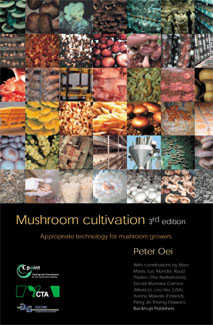

Caught by the mushroom
virus in 1985 and later working for the former Mushroom Tower, I was asked to
write a practical manual on mushroom growing for developing countries in 1991.
When I compiled the first edition, I hadn™t expected to rewrite it for
a second edition in 1996 and now a third edition in 2003. Over 6000 copies have
been distributed all over the world, both in French and English. Intended originally
for developing countries, the book has evolved to its current state. The second
book was already distributed more in Western countries than in the third world
because of its detailed instructions on growing ‚exotic™ mushrooms.
This third edition now gives a detailed view on growing the most important mushrooms
of the world. It also covers recent developments in the highly specialised sector
of White button mushrooms. These new chapters have been provided by experts
in their specific fields: Marc Maas (Cpoint), Luc Klunder (Gicom), and Ruud
Thielen (Thilot). Peter van Erp and Anton Sonnenberg, Applied Plant Research,
kindly permitted me to use parts of the book Mushroom Cultivation, edited by
Van Griensven in 1988, which deals exclusively with White button mushrooms.
Lou Hsu (Unicorn), Edwin Blaak (Blaak Exotic Mushrooms Consultancy), Magda Verfaillie
(Mycelia) and Hannu Mäkelä (Karela Centre of Development) delivered
valuable information on new methods to grow exotic mushrooms on sterilised substrates.
Daniel Martínez-Carrera, Institute Micologia Neotropical Aplicada, Mexico,
kindly revised the case study on mushroom growing in Mexico and gave his view
on rural extension and sustainable development. A special thanks to the other
companies and institutions who sponsored the production of this book: CTA, Limbraco,
Peeten BV and SacO2. Without their help the production of this book wouldn™t
have been possible. Jet Westbroek: thanks for the wonderful cover you designed!
The publisher and I would further like to thank the following people (in random
order) for their contribution to the realisation of this and the previous publications:
Mrs. T. van Megen, CPoint, The Netherlands
Dr. I. Hall, Invermay Agricultural Centre, New Zealand
Mrs. C. de Boer, Organic Producers and Processors Association of Zambia
The late Prof. dr. S. Triratana, Chulalongkorn University, Thailand
Prof. dr. M.S. Ho, Taiwan Provincial Farmers Association, Taiwan
Dr. J.T. Peng, Taiwan Agricultural Research Institute, Taiwan
Dr. C.F. Song, Taiwan Agricultural Research Institute, Taiwan
Dr. Y.M. Liao, Taiwan Agricultural Research Institute, Taiwan
Dr. J. Stalpers, CBS, The Netherlands
Prof. M.Z. Shen, Beijing Agricultural University, China
Dr. H.C. Wang, Fujian Research Institute of Light Industry, China
C.K. Tseng, Fujian Normal Teachers University, China
J.L. Wu, Sanming Mycological Institute, China
Dr. P. Osathaphant, Maejo Institute of Agricultural Technology, Thailand
Ir. P. Sedeyn, Spawn company Mycoblank, Belgium
Ing. O. Harmsen, mushroom farm Euromyco, The Netherlands
Mr. R. Malaga, Ayala Foundation, Philippines
Prof. T.H. Quimio, University of the Philippines at Los Banos, Philippines
Mrs. Y. Mangaoang, University of the Philippines at Los Banos, Philippines
Dr. C.J. Chen, Culture Collection and Research Center, Taiwan
Mr. G. Coppens, Jeco Conserven, The Netherlands
Dr. N. Dam, Dutch Mycological Association, The Netherlands
Dr. B. Buyck, Belgium
Personally, I would like to thank the staff at Backhuys Publishers for their
patience and assistance. Last but not least I would like to thank my wife for
her support and my sons for having the patience to act as models, while I tried
to picture them with mushrooms.
Tiel, June 2003
Peter Oei
Preface
1. Benefits of mushrooms
2. General biological information on mushrooms
3. Substrate characteristics
4. Technical data of mushroom species: an overview
5. Spawn, breeding and conservation of strains in general
6. Environmental care and certification schemes
7. Feasibility: costs and returns
8. Mushroom markets and marketing
9. Organisation: extension and research
10. Practical aspects of spawn production
11. Climate control in general
12. Simple mushroom farms
13. Advanced mushroom farms and tunnels
14. Modern climate control installations
15. Cultivation on fermented substrates in general
16. Casing soil
17. The indoor composting process for Agaricus cultivation
18. Agaricus cultivation: from spawn run to harvest
19. Mechanisation in Agaricus cultivation
20. Cultivation on pasteurised substrates
21. Cultivation on sterilised substrates
22. Lentinula edodes (Shiitake) cultivation on sterilised substrates
23. Cultivation on wood logs
24. The collection and ‚cultivation™ of mycorrhizal fungi
25. Post-harvest handling
26. Pests and diseases
Appendices
A. Safe use of pesticides
B. Conservation of strains and culture collections
C. Spore allergies
D. Maintenance chart
E. Termitomyces: a common genus in Africa and South-East Asia
F. Suppliers
G. Chemical analyses for mushroom cultivation
H. Annotated bibliography
I. Management and motivation
J. Glossary